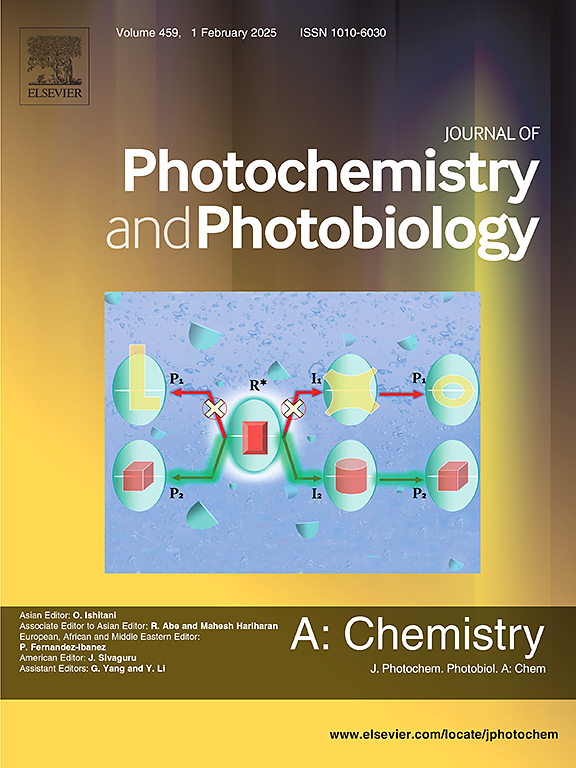γ-环糊精与偶联扩展的强干扰素在固态中具有光致变色和荧光特性的排斥配合物
IF 4.7
3区 化学
Q2 CHEMISTRY, PHYSICAL
Journal of Photochemistry and Photobiology A-chemistry
Pub Date : 2025-06-25
DOI:10.1016/j.jphotochem.2025.116595
引用次数: 0
摘要
由于多功能分子材料的广泛应用,其研究一直是最令人兴奋的研究课题之一。在此,我们报道了两个多功能的超分子主-客体排斥配合物,通过γ-CD与两个共轭扩展的紫外光客体外结合形成,即N,N ' -二(3-羧基-丙基)-4,4 ' -(1,4-苯)-二氯化联吡啶(PV·Cl2)和N,N ' -二(3-羧基-丙基)-4,4 ' -(1,4-萘)-二氯化联吡啶(NV·Cl2)。不相容配合物PV2+∩γ-CD2和NV2+∩γ-CD2在固态中同时表现出光致变色行为和光电可调荧光。其中,NV2+∩γ-CD2在365 nm和430 nm光激发下均表现出荧光活性。由于其具有双读出信号并发性,可以应用于多重防伪和多级信息加密。本研究为构建多功能分子材料提供了一种主客体外显结合策略。本文章由计算机程序翻译,如有差异,请以英文原文为准。

Exclusion complexes of γ-cyclodextrin with conjugation-extended viologens displaying photochromic and fluorescent properties in solid-state
The search for multifunctional molecular materials continues to be one of the most exciting research topics due to their broad range of applications. Herein, we report two multifunctional supramolecular host−guest exclusion complexes, formed through exo-binding of γ-CD with two conjugation-extended viologen guests, namely, N,N′-di(3-carboxy-propyl)-4,4′-(1,4-phenylene)-bipyridinium dichloride (PV·Cl2) and N,N′-di(3-carboxy-propyl)-4,4′-(1,4-naphthalene)-bipyridinium dichloride (NV·Cl2). The exclusion complexes PV2+∩γ-CD2 and NV2+∩γ-CD2 exhibited photochromic behavior and photomodulable fluorescence simultaneously in the solid-state. In particular, NV2+∩γ-CD2 showed fluorescence activity under both 365 nm and 430 nm light excitation. Benefiting from their concurrent dual readout signals, the exclusion complexes can be applied to multiple anti-counterfeiting as well as multi-level information encryption. This study provides a host−guest exo-binding strategy for constructing multifunctional molecular materials.
求助全文
通过发布文献求助,成功后即可免费获取论文全文。
去求助
来源期刊
CiteScore
7.90
自引率
7.00%
发文量
580
审稿时长
48 days
期刊介绍:
JPPA publishes the results of fundamental studies on all aspects of chemical phenomena induced by interactions between light and molecules/matter of all kinds.
All systems capable of being described at the molecular or integrated multimolecular level are appropriate for the journal. This includes all molecular chemical species as well as biomolecular, supramolecular, polymer and other macromolecular systems, as well as solid state photochemistry. In addition, the journal publishes studies of semiconductor and other photoactive organic and inorganic materials, photocatalysis (organic, inorganic, supramolecular and superconductor).
The scope includes condensed and gas phase photochemistry, as well as synchrotron radiation chemistry. A broad range of processes and techniques in photochemistry are covered such as light induced energy, electron and proton transfer; nonlinear photochemical behavior; mechanistic investigation of photochemical reactions and identification of the products of photochemical reactions; quantum yield determinations and measurements of rate constants for primary and secondary photochemical processes; steady-state and time-resolved emission, ultrafast spectroscopic methods, single molecule spectroscopy, time resolved X-ray diffraction, luminescence microscopy, and scattering spectroscopy applied to photochemistry. Papers in emerging and applied areas such as luminescent sensors, electroluminescence, solar energy conversion, atmospheric photochemistry, environmental remediation, and related photocatalytic chemistry are also welcome.

 求助内容:
求助内容: 应助结果提醒方式:
应助结果提醒方式:


